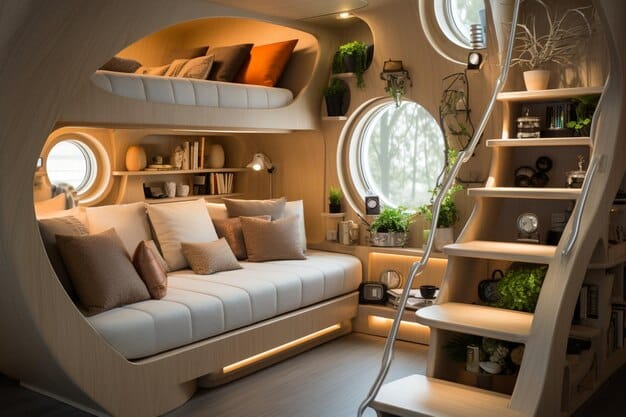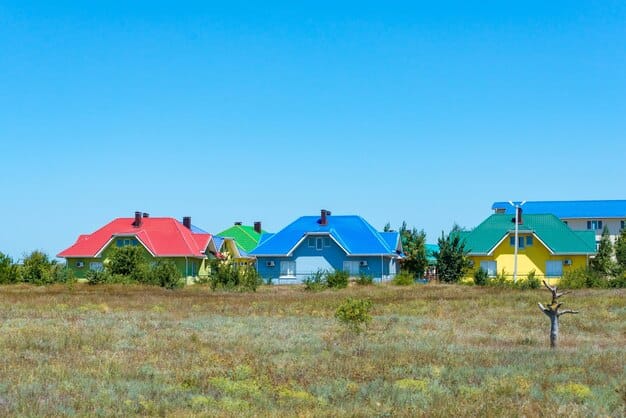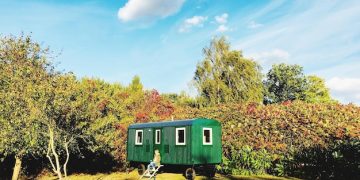Tiny House Subculture: Minimalism & Sustainability in US Housing

The ‘Tiny House’ Subculture represents a significant shift in US housing, driven by minimalism and sustainability, offering an alternative lifestyle that prioritizes financial freedom and environmental responsibility.
The **’Tiny House’ Subculture: How Minimalism and Sustainability are Driving a Housing Revolution in the US**, represents a significant departure from traditional American ideals of homeownership, attracting individuals seeking financial independence and a smaller environmental footprint.
The Rise of the Tiny House Movement
The tiny house movement has gained significant traction in recent years, reflecting a broader cultural shift towards simplicity and sustainability. This movement challenges conventional notions of homeownership and promotes a lifestyle centered around reducing consumption and living within one’s means.
Fueled by a desire for financial freedom and a smaller ecological footprint, individuals across the United States are embracing tiny houses as a viable housing alternative. These compact dwellings, typically ranging from 100 to 400 square feet, offer a unique blend of affordability, mobility, and environmental consciousness.
Economic Factors Driving the Trend
The appeal of tiny houses is closely linked to economic factors, particularly the desire to escape the burden of traditional mortgages and rising property taxes. For many, downsizing to a tiny house represents a pathway towards financial independence, allowing them to save money, pursue their passions, and live life on their own terms.
Environmental Benefits of Tiny Living
Beyond the economic advantages, tiny houses also offer significant environmental benefits. By minimizing their living space, tiny house dwellers reduce their energy consumption, waste production, and overall impact on the planet. This eco-friendly approach to housing aligns with the growing awareness of climate change and the need for sustainable living practices.

As the tiny house movement continues to gain momentum, it raises important questions about housing affordability, urban planning, and the future of sustainable living in the United States. It’s not just about building smaller homes; it’s about reimagining our relationship with material possessions and embracing a lifestyle that prioritizes experiences over accumulation.
Minimalism as a Core Value
Minimalism is more than just a design aesthetic; it’s a philosophy that underpins the entire tiny house movement. It’s about intentionally living with less, focusing on essential possessions, and prioritizing experiences and relationships over material wealth.
For tiny house dwellers, minimalism is not about deprivation or sacrifice, but rather about freedom and intentionality. By shedding unnecessary belongings, they create space for what truly matters: personal growth, meaningful connections, and a more fulfilling life.
- Decluttering and Downsizing: The process of decluttering and downsizing is often a transformative experience for aspiring tiny house dwellers, forcing them to confront their relationship with material possessions and identify what truly holds value.
- Conscious Consumption: Minimalists are mindful consumers, carefully considering each purchase and prioritizing quality over quantity. This approach reduces waste, saves money, and promotes a more sustainable lifestyle.
- Focus on Experiences: By freeing themselves from the burden of excessive possessions, minimalists are able to invest their time and resources in experiences, such as travel, hobbies, and personal growth.
The minimalist ethos extends beyond material possessions to encompass other aspects of life, such as finances, relationships, and time management. By simplifying these areas, tiny house dwellers create greater clarity, focus, and overall well-being.
Sustainability in Tiny House Design and Construction
Sustainability is a central tenet of the tiny house movement, influencing every aspect of design and construction. Tiny house builders are committed to using eco-friendly materials, minimizing waste, and creating energy-efficient dwellings that reduce their environmental impact.
From reclaimed wood and recycled metal to solar panels and composting toilets, tiny houses are often designed with sustainability in mind. This commitment to environmental responsibility reflects a growing awareness of climate change and the need for innovative solutions to address the housing crisis.
Eco-Friendly Materials and Techniques
Tiny house builders often prioritize the use of sustainable materials, such as bamboo, cork, and reclaimed lumber. They also employ green building techniques, such as passive solar design, rainwater harvesting, and greywater recycling, to minimize their environmental footprint.
Energy Efficiency and Conservation
Tiny houses are inherently energy-efficient due to their small size. However, builders often go above and beyond to incorporate energy-saving features, such as solar panels, energy-efficient appliances, and proper insulation, to further reduce their energy consumption.
- Solar Panels: Many tiny houses are equipped with solar panels, allowing them to generate their own electricity and reduce their reliance on fossil fuels.
- Composting Toilets: Composting toilets are a popular choice for tiny houses, as they conserve water and reduce the need for traditional septic systems.
- Rainwater Harvesting: Rainwater harvesting systems collect rainwater for non-potable uses, such as gardening and toilet flushing, reducing the demand on municipal water supplies.
The integration of sustainability principles into tiny house design and construction demonstrates a commitment to responsible living and a desire to create a more environmentally friendly housing alternative.
Navigating Legal and Zoning Challenges
One of the biggest challenges facing the tiny house movement is navigating the complex web of legal and zoning regulations that govern housing in the United States. Many municipalities have building codes and zoning ordinances that are not designed to accommodate tiny houses, making it difficult to find legal places to live.
Despite these challenges, the tiny house community is actively working to change building codes and zoning laws to make it easier for people to live in tiny houses. This advocacy work involves educating local officials, proposing amendments to existing regulations, and demonstrating the benefits of tiny houses for communities.

Understanding Zoning Regulations
Zoning regulations dictate what types of buildings are allowed in specific areas. Many zoning ordinances require minimum square footage for houses, which can exclude tiny houses.
Advocating for Change
Tiny house advocates are working to change zoning laws and building codes to allow for tiny houses on wheels (THOWs) and tiny houses on foundations. This includes advocating for the adoption of the Appendix Q of the International Residential Code (IRC), which provides guidelines for tiny house construction.
The legal and zoning landscape for tiny houses is constantly evolving, as more communities recognize the potential benefits of these alternative housing options. By working together and advocating for change, the tiny house community is paving the way for a more inclusive and sustainable housing future.
Building a Tiny House: DIY vs. Hiring Professionals
Building a tiny house is a significant undertaking that requires careful planning, construction skills, and attention to detail. One of the first decisions that prospective tiny house dwellers must make is whether to build the house themselves or hire professional builders.
Both options have their pros and cons. Building a tiny house DIY can save money and provide a sense of accomplishment, but it also requires a significant time commitment and construction expertise. Hiring professionals ensures quality workmanship and adherence to building codes, but it can be more expensive.
- DIY Construction: Building a tiny house DIY can be a rewarding experience, allowing individuals to customize their homes to their specific needs and preferences. However, it requires strong construction skills, a significant time commitment, and a willingness to learn new things.
- Professional Builders: Hiring professional tiny house builders ensures quality workmanship, adherence to building codes, and a smoother construction process. However, it can be more expensive than building the house DIY.
- Hybrid Approach: Some individuals choose a hybrid approach, tackling some aspects of the construction themselves while hiring professionals for tasks that require specialized skills, such as electrical wiring or plumbing.
The decision of whether to build a tiny house DIY or hire professionals depends on individual skills, budget, and time constraints. Regardless of the chosen path, careful planning and attention to detail are essential for a successful tiny house construction project.
The Future of the Tiny House Subculture
The tiny house subculture is poised for continued growth and evolution in the coming years. As housing affordability remains a pressing issue and environmental concerns continue to rise, tiny houses offer an increasingly attractive alternative to traditional housing options.
Technological advancements, such as smart home technology and sustainable building materials, will further enhance the appeal and functionality of tiny houses. Additionally, the growing acceptance of alternative housing models by municipalities and lending institutions will make it easier for people to access and finance tiny homes.
Technological Innovations
Smart home technology can enhance the functionality and comfort of tiny houses, allowing residents to control lighting, temperature, and security systems remotely. Sustainable building materials, such as cross-laminated timber (CLT) and structural insulated panels (SIPs), can improve energy efficiency and reduce construction waste.
Community Development
The development of tiny house communities offers a sense of belonging and shared resources for tiny house dwellers. These communities can provide access to amenities, such as shared kitchens, laundry facilities, and community gardens, while fostering a sense of collaboration and mutual support.
The future of the tiny house subculture is bright, with the potential to revolutionize housing in the United States and beyond. By embracing minimalism, sustainability, and innovative design, tiny houses offer a pathway towards a more affordable, environmentally friendly, and fulfilling lifestyle.
| Key Point | Brief Description |
|---|---|
| 🏠 Minimalism | Living with less, focusing on essentials. |
| 🌱 Sustainability | Eco-friendly design and construction. |
| 💰 Financial Freedom | Reduced mortgage and living costs. |
| 📜 Legal Challenges | Navigating zoning and building codes. |
Frequently Asked Questions
▼
A tiny house is a small, self-contained dwelling, typically ranging from 100 to 400 square feet. They are designed for simplicity, efficiency, and mobility, offering an alternative to traditional housing.
▼
People are drawn to tiny houses for various reasons, including financial freedom, environmental sustainability, and the desire for a simpler, more intentional lifestyle. It’s a way to downsize and declutter.
▼
No, tiny houses are not legal everywhere. Zoning laws and building codes vary widely by location, and many municipalities have regulations that do not accommodate tiny houses. Research is essential.
▼
The cost to build a tiny house varies depending on the size, materials, and whether you build it yourself or hire professionals. Generally, it can range from $20,000 to $80,000 or more.
▼
Challenges include limited space, navigating legal and zoning restrictions, and adjusting to a minimalist lifestyle. It requires careful planning and a willingness to adapt to a small living space.
Conclusion
The tiny house subculture reflects a growing desire for simpler, more sustainable living in the United States. Driven by minimalism and environmental awareness, this movement offers a unique housing alternative that challenges traditional norms and promotes financial freedom and community. As legal and technological landscapes evolve, the appeal of tiny houses will likely continue to grow, shaping the future of housing in the US.





